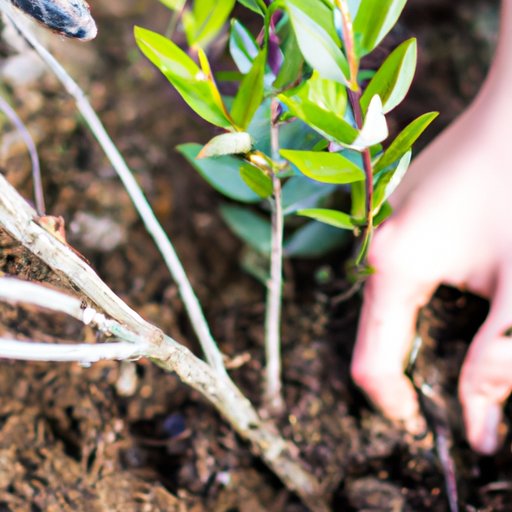Introduction
Blueberries have become an increasingly popular fruit due to their health benefits and delicious taste. Growing and harvesting blueberries in your garden not only provides you with fresh produce but also adds to the beauty of your outdoor space. This article serves as an ultimate guide to help readers plant and care for blueberries.
The Ultimate Guide to Planting Blueberries in Your Garden
Blueberries are an excellent addition to any home garden as they require minimal care and provide many health benefits. They are also considered easy to grow as they do not require a lot of maintenance. To ensure a successful harvest, it is important to choose the right location and to follow the proper planting techniques.
Blueberry plants thrive in soil with a pH range of 4.0 to 5.5 and require at least 6 hours of sunlight per day. It is best to plant during early spring or late fall when the temperature is mild. When planting, dig a hole deep enough to accommodate the entire root system. Place the bush into the hole and make sure it sits level with the surrounding soil. Cover the roots with soil and water generously.
5 Tips for Growing Blueberries in Containers
Container gardening is an excellent option for those with limited outdoor space or who want the convenience of mobility. Blueberry plants can be grown successfully in containers provided the right steps are taken. Choosing the proper container size, type, and soil is essential when growing blueberries in pots.
It is recommended to use a container that is at least 20 inches in diameter and has drainage holes at the bottom. Use a mix of peat moss, pine bark, and perlite as the soil mixture. Water consistently and give fertilizer every two weeks during the blueberry growing season, usually from late spring to early fall.
The Dos and Don’ts of Blueberry Planting and Care
To ensure the healthy growth and yield of your blueberry bushes, there are a few key dos and don’ts you should follow. A common mistake people make is planting blueberries in soil that is not suited for their growth. It’s important to test your soil pH and ensure that it is between 4.0 and 5.5 before planting.
Another common mistake is not pruning the bushes, which results in a lower yield of fruit and diseases. It is important to prune these bushes during the dormant season, generally from December to February, and to remove any weak or diseased branches.
Step-by-Step Guide: How to Plant Blueberries in Your Backyard
Planting blueberries in your backyard is a straightforward process that requires a few key steps for successful growth. The most important step is choosing the right location in your garden to ensure optimal growing conditions.
The first step in planting blueberries in your backyard is to test the pH of your soil to ensure it can support blueberry growth. Once you have chosen the proper location in your garden, you can start digging holes for the bushes. Make sure to keep distance from other plants, so they won’t be sharing any nutrients. Then, place the blueberry bush into the hole and cover the roots with soil. Water the new bush after planting, and provide regular watering and pruning throughout the growing season.
The Best Soil and Fertilizer for Blueberry Plants
Choosing the best soil and fertilizer for blueberries is a crucial factor in ensuring successful growth. Blueberries require acidic soil and are sensitive to changes in pH. It is recommended to use soil that has a pH range of 4.0 to 5.5 for best results.
As for fertilizers, blueberries need a specific balanced mixture of nutrients. It’s suggested to use organic fertilizers and to avoid high nitrogen fertilizers as blueberry bushes prefer nitrogen-rich slow-release fertilizers. Commencing fertilization in the early spring and continuing every two weeks through mid-summer, typically up until July, will help ensure optimal growth.
How to Prune and Maintain Your Blueberry Bushes
Pruning is a crucial factor to successfully growing blueberries, and it helps maintain the overall health of your bushes. Pruning during the dormant season, usually from December to February, provides better airflow, higher yields, and eliminates any spots for disease to grow and spread.
To begin pruning, remove any dead or weak branches. Then, remove any low growth and thin the center of the bush to create a bowl-like shape. Cutting newer growth helps to promote a higher yield for the current growing season.
Top Blueberry Varieties to Plant in Your Garden for Optimal Harvest
Choosing the best blueberry variety for your garden depends on several factors such as the climate, soil type, and personal taste preference. Some of the best blueberry varieties that you can plant in your garden for optimal harvests include:
- Chandler Blueberry
- Biloxi Blueberry
- Northblue Blueberry
- Sunshine Blue Blueberry
- Pink Lemonade Blueberry
These varieties are known for their disease resistance, high yield, and exceptional flavor.
Conclusion
Caring for blueberries may seem daunting, but following these steps ensures a successful growth harvest. Planting blueberries is a great investment in your garden and overall wellness, and maintaining it well can provide a perfect yield.
